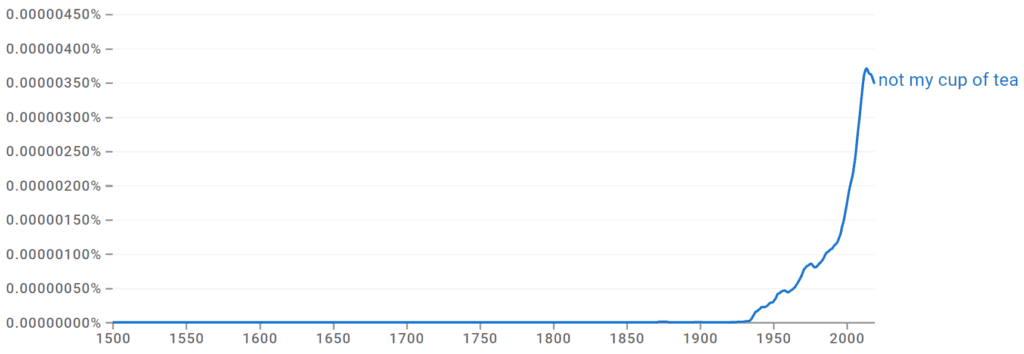The idiom not my cup of tea means something isn’t to your liking or doesn’t align with your preferences. Picture yourself eating an oatmeal raisin cookie when you despise raisins, and chocolate chip is your favorite. That disappointment is the essence of this idiom.
Originating from Britain’s vast love affair with tea, this idiom steers clear of hot water and dips into personal preferences. Idioms are just common phrases that aren’t meant to be taken literally. They spice up our conversations and stir emotions. But only if you use it correctly.
So, pour yourself a cuppa, and let’s go over the meaning, origin, and proper use of the idiom not my cup of tea.
Not My Cup of Tea Meaning

Not my cup of tea is a polite way to express disinterest or dislike for something. It’s the go-to phrase for the British when they’re trying to be politely disdainful. The phrase has no literal connection to tea preferences but serves as a metaphorical expression of personal taste.
For instance, I love to read fantasy romance books, but every now and then, I enjoy sitting down with a thriller. But, don’t even suggest I try reading a horror because it’s not my thing, aka not my cup of tea.
Not My Cup of Tea Origin

Many sources suggest that the origin of this phrase is steeped in Britain’s rich tea culture. In the 17th and 18th centuries, tea wasn’t just a beverage; it was an event, a societal activity. The idiom itself first surfaced in the late 1800s, originally as a positive assertion: my cup of tea meant something someone liked. But by the 20th century, the negative version, not my cup of tea, became far more popular and used to describe something someone didn’t care for.
Not My Cup of Tea Synonyms
- Not to my taste
- Not my thing
- Doesn’t float my boat
- Not up my alley
- Doesn’t tickle my fancy
Examples of Not My Cup of Tea in a Sentence

- I tried watching that new sci-fi series everyone’s talking about, but it’s just not my cup of tea.
- Opera? Sorry, hard pass. That’s not my cup of tea.
- I know you love to watch horror movies, but they’re just not my cup of tea.
- Hiking up steep hills for hours on end? Definitely not my cup of tea.
- I attempted knitting during the lockdown, but I quickly realized it wasn’t my cup of tea.
- Yes, jazz can be really soothing for some, but it’s not my cup of tea. I prefer classical music.
- He tried the vegetarian lifestyle for a month, but it wasn’t his cup of tea.
- While camping under the stars sounds romantic, it’s not my cup of tea; I need a comfy bed!
A Final Sip on the Subject
Not my cup of tea is a classic, always ready to be poured into conversations when you want to gently express your preference (or distaste) for something. Now that you’re fully steeped in knowledge about this idiom, why not brew further insights with our massive collection of idiomatic guides?
